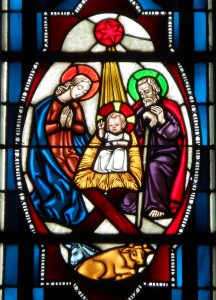Rejoice, for unto us a child is born! 
I tell you that in the same way there will be more rejoicing in heaven over one sinner who repents than over ninety-nine righteous persons who do not need to repent. Luke 15:7
We’re knee-deep into the Holy days (Holidays), a time when nearly everyone around us—religious and secular alike—is making an intentional effort to experience traditions. We’re proud to be a congregation that follows liturgies that have changed little over the past five centuries—indeed past two thousand years. These traditions are a large part of what defines us as a congregation. They have a purpose—one that goes far beyond the emotional ties that familiarity brings. But what is that purpose? Why was the liturgy created?
The liturgy exists to teach. Intentionally repetitive, it stays foundationally the same week after week, year after year. By saying and singing it over and over, we memorize it. Toddlers can participate long before they’re able to read, and their parents can follow along even when their hands are full. At the other end of the spectrum, dementia patients remember and speak along with parts of the liturgy when most other memories are gone.
But what is the liturgy teaching? It condenses the entirety of a Christian’s life of faith into a roughly hour-long microcosm. It was from this premise that Bethany designed our confirmation class syllabus for the entire year. Albeit not in the familiar Catechism order, all of the Six Chief Parts are veiled in the words we say every week. Each service begins with the Invocation—hearing the Name upon us again that was first given at our Baptism. God confronts us with our inability to keep His demands (Ten Commandments), but then immediately gives us His words of forgiveness and grace (Confession and Absolution). We respond by repeating to Him and to each other what He has taught us (Apostles’ Creed), coming to Him in the Lord’s Prayer, and by striving to serve our neighbors. He continues to feed us with the very Bread of Life (Holy Communion), and we depart resting in the knowledge that He will preserve us until the resurrection on the last day.
Our hymnody echoes this, reinforcing the doctrines of the Catechism, and connecting us to all of Scripture and the larger cycle of the church year. And with mention of the church year, we’re back onto the topic of the Holidays. Over the course of several months, we cover the entire story of Christ. Right now, in December, we’re in the first chapter of that story. We celebrate our God stepping into His creation as a helpless Infant. It’s a beautiful story—one that gives us warm fuzzy feelings inside. But this story would mean nothing if this one chapter were all there is.
This year’s children’s Christmas pageant acknowledges this. Drawing on the power of repetition, it simply quotes those chapters of Luke and Matthew that we read and hear every year. But unlike many other pageants, it doesn’t conclude with the Infant in the manger, or even with the Wise Men. It guides us to the same place that all our church traditions are meant to lead—the foot of the Cross.
Embrace our traditions this Holiday season. Come to Old Fashioned Christmas on December 9th, and delight in the presentation of the Christmas story by our youth. Attend our Advent and Christmas Eve services, and rejoice in the treasures bestowed in the liturgy. Reread Luke chapter 2—and also chapters 22-23. And in all of these traditions, remember the purpose they serve. They guide us to that Infant in the manger—that Man on the Cross—that resurrected King, Who came to give us Forgiveness and new life.
We have been given the greatest Gift, so rejoice in Him during our Christmas season.
Sincerely and In Christ, Bethany Heimann, Confirmand Education Coordinator
Joshua Konkle, Elder